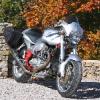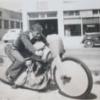Leaderboard
Popular Content
Showing content with the highest reputation on 01/11/2024 in all areas
-
I saw a few of these in Afghanistan, where Russian contractors operated light freight. They had enclosed bodies, looked like they were carrying a VW bus. Goofy, reliable, and fun to watch. Has a console drink holder for the Vodka.3 points
-
3 points
-
On 15M bikes you can use the air bleeds to change the idle speed so both can be adjusted as long as the balance is maintained. Breva 750 is basically the same.3 points
-
Somehow, YouTube's algorithm popped up with this 1960s Soviet designed twin radial-engined helicopter: the Kamov Ka26. Normally a utility and crop-dusting craft, the radial engine thunder and the whine of the cooling fans on the shrouded engines lends an almost Guzzi-like, visceral quality to it. Pilots seem to love it, as it is very benign handling for a 'copter. Apparently, if you lose an engine, you simply have a slower craft.2 points
-
I'd buy a set of these but that would be a "step down" for me. Get it/..."step down" lol. I'm here all week folks. Phil2 points
-
Dropped a boiled egg in the dirt ~ Carl Barron Couldn’t find clip but this’ll do as a stand in2 points
-
Rebalancing for piston weight is really a non-issue. Anybody who has talked to professional tuners knows there is a wide range of balance factors for single and twin cylinder engines; the longer the crankshaft, the more critical balance becomes due to torsional harmonics, number of main bearings etc. But for our big dumb lumps, there's a generic recipe for 90* twins, and some accommodation for the resonance in the frame for felt vibration. In my '85 LM1000, I installed Carrillo rods under the stock pistons without a rebalance, and it became dead smooth at all RPMs, losing the annoying handlebar vibration around 4000 rpm. I was as surprised as anyone. Balance factor has only 2 functions, comfort and mechanical durability; for instance, old British twins would literally break the crankcases if the balance factor got too far away from 50% (iirc) On something like a big block 'Guzzi or H-D Sportster, the crank and cases are so overbuilt it's simply not a structural issue. For me, I would never tear down an engine to rebalance it unless it proved uncomfortable, or if it was going to be thrashed within an inch of it's life at maximum effort.2 points
-
Where my learning curve caught up with me, I had added significant preload to the stock forks because the springs were too soft for me. During a very sharp, low speed cornering correction (sudden increase in lean angle), the road went "off camber", essentially asking the suspension to "reach out" to maintain contact patch. The excessive preload caused the suspension to "top out", loose contact, and slide. Read: low-side. I realize there were several other factors, including rider error, but it would have been better if my forks had a little more "reach" (extension travel) that I had defeated with the excessive preload attempt to compensate for the soft springs. Just my one sad, but true, story to illustrate the importance of spring selection first, then preload, then damping.2 points
-
The simple old-fashioned way to check suspension travel is to place a zip-tie on the fork tube, go through your areas of concern and read the travel via the zip-tie which has been pushed up the tube to record the maximum travel. 'Harshness' a LaGrasta stated about his driveway transition is not a function of spring (unless actually bottoming the fork) as it is too much compression damping. That said, if you're a fast rider, you may need that control at high speed which feels harsh at low-speed big bumps. My 'Sport is set up so that if I encounter a big pavement change such as parking lot/driveway, it will actually bottom; if I'm banging through the Dragon, it will compress to about less than an inch of max travel. At higher speeds, nowhere near that as cornering doesn't generate the G force that braking can. Let me make clear that I am no suspension scientist, just have my subjective feels, lightweight science such as zip-ties, a lot of personal experience from Roadracing, flat track, observed trials, and decades of anecdotal education from amateur and professional suspension users.2 points
-
Springs can loose their "spring". It does happen. But it would be unusual for it to happen on a motorcycle spring. It tends to happen, for example, on Jeep JK's, which use coil springs, if your springs are low quality and not properly heat treated. That, combined with the heavy nature of a Jeep, can result in the springs sagging. But I doubt the stock V11 spring would be prone to that. More likely what might feel like the springs being worn out is the shocks being worn out. The shocks are there to control the springs. That said, the stock spring is not always the right rate for the rider depending on the riders weight and riding style. Preload does not, as mentioned, change spring rate. Preload sets ride height when you are on the bike riding down the road. Adding preload will make the bike ride higher when you are on it riding down the road. That can be a good thing, but it won't make a spring that is too soft stiffer if you add preload. This has been covered repeatedly on here, but a standard path forward is to fully set sag. Setting sag will tell you if your springs are too soft, too hard, or right. If the sag of the bike is right with you on the bike (Race Sag is the term used for that), but the bike sags too much under just its own weight the springs are too stiff. If the Race Sag is right but the bike sags too little under just its own weight the springs are too soft (that means you had to add too much preload into the spring to get the Race Sag right, so sag under just the weight of the bike was reduced). Yes, it can sound backwards. If Race Sag is right and the bike sags the right amount under just the weight of the bike your spring rate is good. From there you can go about adjusting dampening to get the ride quality you are looking for. Harsh ride over jolts can be a lack of spring rate, but it can also be a lack of dampening. Set your sag first, and if required change your springs so sag is right. Then adjust dampening. A longer rear shock usually means higher ride height at the rear. But, as mentioned, it does not always mean that. The spring rate and preload do play a role. But with most longer rear shocks you are increasing the ride height at the rear.2 points
-
Yeah, mine too. The explanation as well. EDIT: found it https://en.wikipedia.org/wiki/Will_it_play_in_Peoria%3F2 points
-
No. Preload can help to get the ride height right, as long as the springs have approximately the right rate. If you are bottoming out regularly, the spring rate is perhaps too soft, or the springs have maybe lost something due to age. Having said that, I'm nor exactly a suspension Guru, but I believe that is correct.2 points
-
Crop dusting all that grain, one's mind begins to think about what could be made from all that grain. On a hot and dusty day. Or a rainy day. A gray day. Any day...1 point
-
I just came across a set of these in my parts shed that I got from "way back when". I've converted my bike to remove the cross over, so I don't need them anymore. I'll post them up for sale on the classified.1 point
-
So many great explanations, thank you all. After evaluating what I've adjusted, how it's reacting and what you've each advised; I believe my springs may be too soft. I think I'm the third owner of this bike. The guy I bought it from weighed more than me, albeit he did not ride it more than a 1,000 miles in over 10 years of ownership . My conclusion is the first owner must have been lighter than I and replaced the stock springs because the OEM springs should certainly be able to handle my 170lbs and gear no problem. I guess this gives me the start of my 2024 Christmas list.1 point
-
I purchased a set from a member here several years ago. I didn't install them and have decided not to. They are well made. I have Ducati Monster pegs on now, which are the same as stock MG but with rubber padding.1 point
-
These throttle bodies or throttle body assembly are/is similar to the V11 set-up. The difference being things are not as tamperproof on the V11. This setup Pete was using keeps the "tuner" from tampering with idle adjustment , throttle body synch. and apparently TPS . The idle speed is controlled by the IAC motor and it is controlled by the PCM. The v11 allows us to customize our bike to our "satisfaction or dissatisfaction !1 point
-
https://www.cycleworld.com/blogs/ask-kevin/four-stroke-engine-power-explained/?utm_source=Cycle+World+MC&utm_campaign=4827f51dfe-CW_EMAIL_CAMPAIGN_010724&utm_medium=email&utm_term=0_3a16588fbb-4827f51dfe-453096853 Kevin’s article adds explanation to the MR hi-comp chamber/piston improvements that assists combustion & increases compression Well worth a thoughtful contemplation1 point
-
Yep: not V11. Sure, still could be interesting . . . topic moved.1 point
-
I have to comment on this. Willie Soon takes the fact that some hydrocarbons have a non biological source as evidence that burning it does not cause climate change. He knows he is wrong, but is funded by Exxon Mobil, among others, to tell lies to gullible people. Tucker Carlson is a well-known purveyor of "alternative facts" otherwise known as BS. A better source of information is the NASA website. https://climate.nasa.gov/1 point
-
1 point
-
Yes. As I understand it, if you dial in too much preload, your suspension will top out when the wheel "falls into a hole". If you have to dial in that much preload to get the ride height to where it should be, your springs are too soft for the weight to be carried. If the springs are too soft, they will bottom out regardless of what you do with the preload.1 point
-
I think the best way to think of preload is it places the (loaded) bike on average at the center of the springs range of travel, so that the spring experiences minimal occurrences of full extension and full compression. Personally, I like having my shock spring rate where my normal load requires zero (or close to zero) preload, and I just dial in more preload for extra luggage and/or passenger. On the other hand, from experience, I have noticed fork springs are usually designed with a minimum preload built in, even with the preload adjuster set to minimum. Possibly due to the fact that forks don't use the rising rate frame geometry typically seen for rear shocks. During use, damping also affects spring travel. When a bump is encountered and the suspension starts moving (accelerating), damping is what diminishes the inertia of that motion, for after the bump impact is absorbed.1 point
-
I can't verify that 100%, but I have heard and read many times that springs can get shagged out. And I've ridden and driven a couple of vehicles where that was obviously the case.1 point
-
First priority: get the right springs. More preload will not solve that. I had to learn this "the hard way" . . .1 point
-
To add to Pete's reply, here is the skinny on those throttle bodies from Pete himself. Very informative... When I was looking for a carc bike, it was surprising how some of the owners didn't have a clue about this. Also check on swing arm bearing service. Again, some owners didn't know how they came under lubricated when new. If service was never done, it is better if the bike has low mileage and not seen much moisture, IMO. Both my CARCs had under 7k, so I i wasn't too worried. This winter I will do the deed. Also make sure the engine has roller tappets and not flat. 2012 was the cutoff serial numbers, but as Pete has poi ted out before, this needs to be inspected for positive confirmation and not rely on just serial numbers. Lots of info on these three items in search.1 point
-
What a beautiful day to ride…blue skies, cold and crisp, little traffic, very few motorcycles out today…fair weather riders…probably too cold! Several layers, balaclava and good gloves makes the riding very enjoyable. Good music in the helmet…just perfect! 140 miles on the Scura through the forest…halfway thru stopped for a Peppermint Latte to warm up! Still feels like the holidays! Scura runs like a champ!!1 point
-
1 point
-
Plates should be ready this Friday but we are expecting some solid snow here in Seattle at the end of this week, so I will have to see how the roads are that day. Will keep you all posted.1 point
-
If I had a set of them I would install them when I had the engine apart for anything. It is a fair amount of work to install them, so taking the engine apart to install them for no other reason might not be the cheapest idea. Still a good idea, but better if the engine is having work done already. As I recall, the Mike Rich pistons improve the shape of the combustion chamber (the space between the cylinder head and the piston), improving the squish area, as well as increasing the compression ratio for faster and more complete combustion. I would not expect a massive difference, but on bikes I have done similar mods to I have experienced better throttle response and a small increase in torque. No earth shaking power, they aren't going to turn your V11 into a top fuel dragster, but an improvement none the less.1 point
-
1 point
-
No. Soon will begin your journey ‘Superstition is like a magnet. It pulls you in the direction of your belief.’ -Master Po0 points
-
0 points












